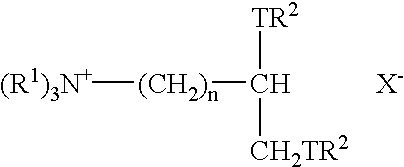Fabric conditioning compositions
a technology of compositions and quaternary ammonium materials, applied in the field of fabric conditioning compositions, can solve the problems of product stability upon storage, triethanolamine thickening, and conditioning compositions containing quaternary ammonium materials, and achieve the effect of reducing the size of liposomes and reducing the depletion of flocculation
- Summary
- Abstract
- Description
- Claims
- Application Information
AI Technical Summary
Benefits of technology
Problems solved by technology
Method used
Image
Examples
example 1
[0142] The following compositions comprising cationically emulsified silicone were prepared as follows:
[0143] Water was heated to 70.degree. C. The quaternary ammonium material, fatty complexing agent and nonionic surfactant were co-melted and added to the water. The mixture was then allowed to cool to 50.degree. C. (samples A to C) or 30.degree. C. (samples D and E). Perfume was then added (samples A to C and E) and the mixture milled using a Janke arid Kunkel mill on high setting. For sample D the perfume was added after milling.
[0144] The silicone emulsion was then added and the mixture was further milled, as required.
2 TABLE 1 A B C D E Quaternary ammonium 12.50 11.40 11.40 11.11 13.00 material (1) Fatty complexing 0.50 1.60 1.60 1.89 1.89 agent (2) Nonionic surfactant (3) 0.75 0.75 0.75 0.75 0.60 Silicone emulsion (4) 5.00 5.00 5.00 5.00 5.00 Preservative (5) 0.04 0.04 0.04 0.04 0.04 Dye 0.0049 0.0049 0.0049 0.0049 0.0049 Perfume (6) 0.95 0.95 0.95 0.95 0.95 Water To 100 To 100...
example 2
[0148] The following conditioning compositions comprising a nonionically emulsified silicone were prepared as follows:
[0149] In samples F, H and 1, water was heated to 70.degree. C., the quaternary ammonium material, fatty complexing agent and nonionic surfactant were co-melted and added to the water. The mixture was then allowed to cool to between 30.degree. C. and 50.degree. C. and perfume added. Finally the silicone was added to the mixture with milling using a Janke and Kunkel mill on high setting, as required.
[0150] In samples G and 2, the water was heated to 70.degree. C., and the silicone emulsion was added to the water. The quaternary ammonium material, fatty complexing agent and nonionic surfactant were co-melted and added to the water / silicone emulsion mixture. The mixture was then allowed to cool to between 30.degree. C. and 50.degree. C. and perfume added. Finally the mixture was milled using a Janke and Kunkel mill on high setting, as required.
4 TABLE 3 F G H 1 2 Quater...
PUM
| Property | Measurement | Unit |
|---|---|---|
| droplet size | aaaaa | aaaaa |
| temperature | aaaaa | aaaaa |
| iodine value | aaaaa | aaaaa |
Abstract
Description
Claims
Application Information
 Login to View More
Login to View More - R&D
- Intellectual Property
- Life Sciences
- Materials
- Tech Scout
- Unparalleled Data Quality
- Higher Quality Content
- 60% Fewer Hallucinations
Browse by: Latest US Patents, China's latest patents, Technical Efficacy Thesaurus, Application Domain, Technology Topic, Popular Technical Reports.
© 2025 PatSnap. All rights reserved.Legal|Privacy policy|Modern Slavery Act Transparency Statement|Sitemap|About US| Contact US: help@patsnap.com



